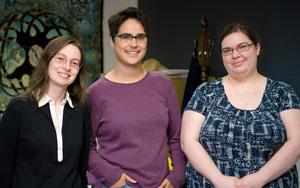September 8, 2011
By William Sweet
Three young professors at Amherst are getting an unusual opportunity to expose students to biomathematics, an innovative blend of math and the natural sciences. At a time when advances in science and medicine are becoming increasingly complex, researchers cannot afford to be isolated from one another in their respective departments, they say.

(left to right) Tanya L. Leise, assistant professor of mathematics; Sheila S. Jaswal, assistant professor of chemistry, and Amy S. Wagaman, assistant professor of mathematics.
“Biology has become too complex for biologists to handle on their own. It’s the interdisciplinary teams that really allow you to make progress now,” said Tanya L. Leise, assistant professor of mathematics and one of Amherst’s three principal investigators with the new Four College Biomathematics Consortium.
Last month, the National Science Foundation awarded a $1 million grant to fund research in biomathematics at Amherst, Hampshire, Mount Holyoke and Smith colleges over the next five years. Sheila S. Jaswal, assistant professor of chemistry, and Amy S. Wagaman, assistant professor of mathematics, are the other two Amherst envoys to the team of nine instructors who received the grant. The NSF awarded Amherst $182,723 of the grant.
All will spend this fall identifying sophomores who may be interested in undertaking this boundary-crossing research. Faculty will become familiar with one another’s fields through a series of fall seminars, and students will start with a course in the spring, based at Smith, but taught by faculty from all four colleges.
Biomathematics combines math, statistics and computer science with biology and medicine. Using quantitative methods, scientists can map complicated biological systems as diverse as the human genome and forest ecosystems.
“Mathematics used to be seen more as a service collaborating with physics and engineering, but I think more and more there’s been a big shift to more collaborations with biology and medicine,” Leise said. “It’s where the real interesting problems are emerging right now.”
In truth, such interdisciplinary research has been in the works already: Amherst started a class in biophysics last year, as part of its new Biochemistry and Biophysics Program, and Smith currently offers a concentration in the biomathematical sciences.
Leise had already been working for some time with Mary Harrington, Smith’s Tippit Professor in Life Sciences, researching the circadian rhythms in mice with five biology students from Smith and two math students from Amherst. Since last fall, Jaswal and Wagaman have been putting their interns to work on protein folding, studying structural changes in molecules essential for life. Studying how these molecules behave may lead to advances in treating disease.
“We figured out we had something we could get a student interested in pretty fast, and it kind of took off,” Wagaman said. Since last fall, three students have come aboard the protein folding project. Jaswal said Wagaman was “the perfect catalyst” for accelerating and deepening her research. Instead of turning to the Internet and third-party sources to support her work, she now has a partner who is helping her learn the language of math.
This is the nature of interdisciplinary research, said Leise. “You can take it much further. You’re not limited by your own expertise.”
With staff from disparate fields working together over four campuses, students will have more time and depth to make interdisciplinary connections, the faculty members said.
The idea is, for instance, to get life science students more comfortable with math, Wagaman said, “so that they’re not coming up to their thesis and being, ‘Augh! I have to learn some math now.’”
Applying mathematic concepts to biological phenomena helps students better grasp abstract math, said Leise. “Some students eat that up, and they love it. Many students want something more tangible and more concrete.”
The NSF is particularly interested in addressing the problem of young women and minorities being underrepresented in the sciences. Stereotypes still exist that discourage some students from considering math or science as an option.
She believes that the biomathematics initiatives are “breaking those stereotypes,” not just by allowing students to see young women scientists and mathematicians in leadership roles, but also by helping female and minority students gain their own experience, comfort and expertise in doing research.
Noted Wagaman: “The more we can do to help people who have no concept of what it’s like to do research, who don’t have a family connection to someone in academia or research, the better.”